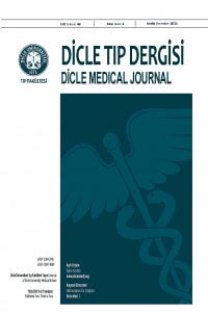The Most Important Factors in Prognosis Of Obstetric Patients with Disseminated Intravascular Coagulation: A Tertiary Center Study
Obstetrik Dissemine İntravasküler Kuagülasyonlu Hastaların Prognozunda En Önemli Faktörler: Tersiyer Bir Merkez Çalışması
___
1. Papageorgiou C, Jourdi G, Adjambri E, et al. Disseminated Intravascular Coagulation: An Update on Pathogenesis, Diagnosis, and Therapeutic Strategies. 2018; 24: 8–28.2. Gezer S. Dissemine intravasküler koagulasyonun tanı ve tedavisi. HematoLog. 2012; 2:2.
3. Rodger L. Syndromes of Disseminated Intravascular Coagulation in Obstetrics, Pregnancy and Gynecology: Objective Criteria for Diagnosis and Management. Hematology/Oncology Clinics of North America. 2000; 14: 999-1044.
4. Callaghan WM, Creanga AA, Kuklina EV. Severe maternal morbidity among delivery and postpartum hospitalizations in the United States. Obstet Gynecol. 2012; 120: 1029-36.
5. Levi M. Disseminated intravascular coagulation (DIC) in pregnancy and the peri-partum period. Thromb Res. 2009; 123: 63-4.
6. Peker N , T uran G , A ydın E , e t a l. A nalysis o f Patients Undergoing Peripartum Hysterectomy for Obstetric Causes According to Delivery Methods: 13- Year Experience of a Tertiary Center. Dicle Med. Journal. 2020; 47: 122-9
7. Taylor FBJ, Toh CH, Hoots WK, et al. Towards definition, clinical and laboratory criteria, and a scoring system for disseminated intravascular coagulation. Thromb Haemost. 2001; 86: 1327-30.
8. Rattray DD, 0’Colleen CM, Baskett TF. Acute disseminated intravascular coagulation in obstetrics: a tertiary centre population review (1980 to 2009). J Obstet Gynaecol Can. 2012; 34: 341-7.
9. Erez O, Novack L, Beer-Weisel R, et al. DIC score in pregnant women – a population-based modification of the International Society on Thrombosis and Hemostasis score. PloS One. 2014; 9: 93240.
10. Kor-anantakul O, Lekhakula A. Overt disseminated intravascular coagulation in obstetric patients. J Med Assoc Thai. 2007; 90: 857-64.
11. Munoz MC, Montes R, Hermida J, et al. Effect of the administration of recombinant hirudin and/or tissue–plasminogen activator (t–PA) on endotoxin– induced disseminated intravascular coagulation model in rabbits. Br J Haematol 1999; 105: 117–21.
12. Dippel AL. Bull. Johns Hopkins Hosp. 1934; 54: 24–34.
13. Tricomi V, Kohl SC. Fetal death in utero. Am J Obstet Gynecol 1957; 74: 1092–8.
14. Suresh I, Vijaykumar TR, Nandeesh HP. Predictors of Fetal and Maternal Outcome in the Crucible of Hepatic Dysfunction During Pregnancy. Gastroenterology Res. 2017; 10: 21-7.
15. Brăila AD, Gluhovschi A, Neacşu A, et al. Placental abruption: etiopathogenic aspects, diagnostic and therapeutic implications. Rom J Morphol Embryol. 2018; 59: 187-95.
16. Vanderschueren S, De Weerdt A, Malbrain M, et al. Thrombocytopenia and prognosis in intensive care. Crit Care Med. 2000; 28: 1871-6.
17. Wada H, Mori Y, Okabayashi K, et al. High plasma fibrinogen level is associated with poor clinical outcome in DIC patients. Am J Hematol 2003; 72: 1– 7.
18. Başaranoğlu S, Evsen MS, Ağaçayak E, et all. Evaluation of obstetrical patients with disseminated intravascular coagulopathy–tertiary center experience. J Matern Fetal Neonatal Med. 2016; 29: 2929-33.
- ISSN: 1300-2945
- Yayın Aralığı: 4
- Başlangıç: 1963
- Yayıncı: Cahfer GÜLOĞLU
Lomber Disk Hernisi Cerrahisinde Uygulanan Farklı Anestezi Yöntemlerinin Karşılaştırılması
Hemodiyaliz Hastalarında Kateter İlişkili Kan Dolaşım Enfeksiyonlarının Değerlendirilmesi
Enver YUKSEL, Şafak KAYA, Emrah GUNAY
Cerebral Hemodynamic Response To Menstrual Cycle In Migraine
Ayca OZKUL, Hasibe Ozgecen DINCEL, Ali AKYOL
Tuberculosis Knowledge Levels Of Secondary School Students
Omer EKINCI, Senar EBINC, Ali DOGAN, Cengiz DEMIR
Parkinson's Disease Profile – A 17-Year Patient Analysis
Ahmet ADIGUZEL, Unal OZTURK, Sibel ALTINAYAR
Evaluation of Corneal Aberration Alterations After Accelerated Transepithelial Corneal Crosslinking
Mehmet Gökhan ASLAN, Yavuz ORUC
Handan ALAY, Ayşe Ferdane OGUZONCUL, Ayşe TORUN, Gülnur KUL, Selma TOSUN, Fethiye AKGUL, Emine KUCUKATES, Raziye GÜMÜŞTAKIM, sevil alkan çeviker, Fatma KESMES CAN, Asiye Bahar KACMAZ, Hüseyin Aytaç ERDEM, Ebru DEMİRAY GÜRBÜZ, Uğur KOSTAKOGLU, Hilal BÖLÜKBAŞI, Nuray KASAR, Emre GÜVEN, Serap PAMUKÇUOĞLU
Treatment management of giant retroperitoneal localized liposarcoma
Hüseyin BİLGE, Ömer BAŞOL, Mehmet RENÇBER, Gizem YAMAN, Abdullah OĞUZ
Psychological Stress of Healthcare Workers Caused by the COVID-19 Pandemic
Gülşen YALCIN, Bahattin SAYINBATUR, Eyaz KARAY, Merve KARAKAS
